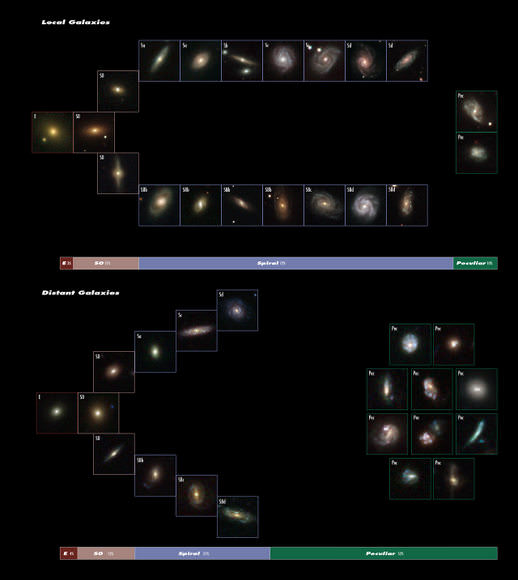[/caption]
Galaxies come in all sorts of shapes. But in the past, the various galaxy shapes used to be more diverse and “peculiar” than they are now. Over time, according to a new study, galaxies tend to become spirals. “Six billion years ago, there were many more peculiar galaxies than now — a very surprising result,” said Rodney Delgado-Serrano, lead author of a new paper. “This means that in the last six billion years, these peculiar galaxies must have become normal spirals, giving us a more dramatic picture of the recent Universe than we had before.”
Using data from the Hubble Space Telescope and the Sloan Digital Sky Survey, a team of astronomers created the first demographic census of galaxy types at two different points in the Universe’s history, putting together two Hubble sequences from different eras that help explain how galaxies form. The results showed that the Hubble sequence six billion years ago was very different from the one that astronomers see today.
The top image represents the current — or local — universe, and the bottom image represents the make up of the distant galaxies (six billion years ago), showing a much larger fraction of peculiar galaxies. In sampling 116 local galaxies and 148 distant galaxies, the researchers found that more than half of the present-day spiral galaxies had so-called peculiar shapes only 6 billion years ago.
Edwin Hubble invented the Hubble Sequence, sometimes called the Hubble tuning-fork diagram. The diagram divides galaxies into three 3 broad classes based on their basic shapes: spiral, barred spiral, and elliptical.
“Our aim was to find a scenario that would connect the current picture of the Universe with the morphologies of distant, older galaxies — to find the right fit for this puzzling view of galaxy evolution,” said François Hammer of the Observatoire de Paris who led the team of astronomers.
The astronomers think that these peculiar galaxies did indeed become spirals through collisions and merging. This is contrary to the widely held opinion that galaxy mergers result in the formation of elliptical galaxies, but Hammer and his team propose a “spiral rebuilding” hypothesis, which suggests that peculiar galaxies affected by gas-rich mergers are slowly reborn as giant spirals with discs and central bulges.
Crashes between galaxies give rise to enormous new galaxies and, although it was commonly believed that galaxy mergers decreased significantly eight billion years ago, the new result implies that mergers were still occurring frequently after that time — up to as recently as four billion years ago.
Link to higher resolution version of the top image.
Papers:
Hammer, et al.
Delgado-Serrano et al.
Source: Space Telescope Institute


The entire Universe seems to be evolving 😉
Great article Nancy, could we have a link to a Hi-res version of the diagrams please?
Do these interesting findings interpret something or giving any hints to our currently known universal? i.e. what source or energy that provide the “pressure” etc. Wish to hear more critical thinking and unthought hypothesis. Great paper =)
Quote: “Hammer and his team propose a “spiral rebuilding” hypothesis, which suggests that peculiar galaxies affected by gas-rich mergers are slowly reborn as giant spirals with discs and central bulges.”
It is interesting to read this. An elliptical galaxy probably has some net rotation. Otherwise it would impode into the center. So if there is rotation this should set up the matter density “waves” which lead to spiral structure.
LC
Hi res version on the ESA site http://sci.esa.int/science-e/www/object/index.cfm?fobjectid=46421
Thisassumes that the grand spirals are the “end-product.” They may just be abnother stepin the “evolving” universe. They may indeed end up elliptical.